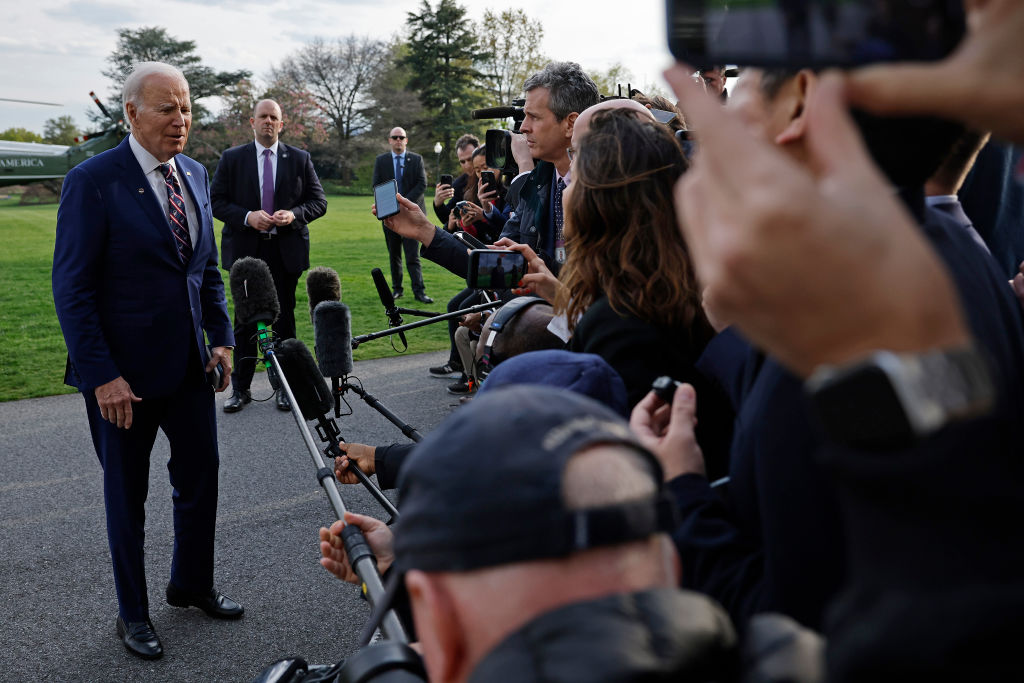In early January, President Joe Biden called a cabinet meeting in the West Wing of the White House. Over the holidays, a wave of flight cancellations by Southwest Airlines had left thousands of Americans stranded at airports for days. The face of the government response on cable news had been Biden’s Transportation Secretary and one-time rival for the Democratic nomination, Pete Buttigieg, who had been one of the administration’s most visible talking heads for months. Multiple clips of Buttigieg holding his own against combative anchors had gone viral. When Biden saw Buttigieg, the President flashed his unnaturally white teeth.
“Hey, TV,” Biden tossed at Buttigieg, say two people familiar with the meeting. It was a targeted jibe. Officials in the room saw it as a good-natured reminder to Buttigieg that, while it was his job to be out in front of a bad news cycle, he was representing Biden, not himself.
The subtle moment spoke volumes about how Biden has managed to clear the field within his own party for a re-election bid that many in his party never wanted. As Biden entered the White House in 2021, insiders predicted he would hold the Oval Office for one term and then step aside. A year ago, the conventional wisdom was that Biden might run again, but that he would have to fend off serious challengers in a contested primary, including possibly figures from within his own cabinet.
That thinking has completely fallen apart. Despite a recent poll showing most voters don’t want the oldest President in American history to run for another term, none of the party’s most credible candidates are taking any steps toward a run. The two most prominent Democrats vying for President thus far—Marianne Williamson and Robert F. Kennedy Jr.—are not seen by party insiders as serious threats to Biden’s glide path to the nomination.
“There isn’t an opening” for a Democratic challenger, says a Biden aide who tracks his polling closely. “You’re not going to challenge somebody that you can’t beat,” adds another Biden adviser. Across the country, the Democratic Party’s biggest stars have conceded that point.
In some cases, the President brushed back would-be challengers after bringing them into his administration, like Buttigieg and Commerce Secretary Gina Raimondo. For others, like Senators Bernie Sanders and Elizabeth Warren, he’s incorporated some of their pet initiatives into his own agenda. Many of Warren’s former advisors and staff now populate the senior ranks of the Consumer Financial Protection Bureau and are in key spots running Biden’s trade policy. And Biden has echoed Sanders as he pressured pharmaceutical companies to swallow cuts to the prices Medicare pays for essential prescription drugs like insulin. With Democratic governors that have hinted at future presidential runs, like California’s Gavin Newsom and Illinois’s J. B. Pritzker, Biden has carved out extra time to meet them over his two years in office and deliver on the needs of their states.
While Biden formally launched his re-election campaign on Tuesday with the release of a 3-minute video, the Biden 2024 effort has been well underway since last year, with aides building out a roster of experienced campaign hands and a fundraising calendar. Yet his poll numbers are still in the low 40s, dragged down by voters’ concerns over Biden’s age. (The President turned 80 in November and, if elected to a second term, would finish out his service at the age of 86.)
Much like he did with his 2020 campaign, Biden is expected to again lean into his experience. Presidential success requires as much an ability to manage the political winds as it does executing sound policies, and Biden’s pitching to voters that he’s cracked the code by not letting the news cycle drive his day. In these polarized times, his 2024 campaign will argue that Biden is uniquely able to simultaneously work with Republicans on issues like fixing the country’s aging infrastructure, bringing back high-tech manufacturing and pushing through some limited gun control measures, while advancing the ball on priorities for the left, like the climate crisis, student loan relief and easing marijuana sentencing.
“Let’s finish this job,” Biden says in the video his campaign released Tuesday morning.

Biden allies say highlights of his first term, such as passing an infrastructure bill, as well as his handling of crucial pivot points like Russia’s invasion of Ukraine and the midterm elections, demonstrate his ability to keep from getting thrown off course by political storms. Such accomplishments assuaged factions of the party’s base enough to shut down some potential primary challenges before they could get off the ground.
The $1 trillion infrastructure bill—a rare bipartisan accomplishment in a hyperpartisan Washington—is likely to play a key role in his campaign message.
“Bidenism fundamentally is optimism,” says Matt Bennett, a longtime Democratic strategist who now calls the centrist think tank Third Way home. “He’s optimistic about working with the Republicans. Actually thinks he can get some deals with these guys.”
No President in 40 years had managed to navigate the narrow political waters to secure a once-in-a-generation infrastructure deal. But the effort was a rocky one. Days before Congress moved the bill to his desk in November 2021, Biden was lobbying House progressives on a tense call in which he vowed to get to their priorities later if they backed the infrastructure bill on its own first. At the time, it seemed like the President had caved to Republicans and centrists in his party. Pundits wondered if it would open Biden up to a challenge from the left. But months after securing the infrastructure funding, Biden managed to keep Democrats together to push through the Inflation Reduction Act, a sweeping measure that advanced large chunk of his agenda, including capping Medicare prescription drug costs, creating a new corporate minimum tax, and securing massive investments in energy and climate reforms.
More than a year later, Biden’s advisors see the legislative two-step as a masterstroke in political patience and proof that the President can deliver on policy by trusting his instincts.
That experience has also come to bear on Biden’s handling of the war in Ukraine, his advisors say. While the deadly and chaotic 2021 withdrawal from Afghanistan is sure to be fodder for GOP lines of attack next year, Biden’s team believes voters will reward the President for his ability to marshal allies against Russia’s invasion, keeping European nations on board with supplying weapons to Ukraine, and helping expand the North Atlantic Treaty Organization.
As Biden’s age continues to draw discomfort, Democrats are expected to emphasize the value of having a tested leader in the Oval Office to address such challenges as a more aggressive Russia. Voters “want experience, and they want a steady hand, and they see the alternative is chaos, and they feel that, and this country has been through a lot of chaos,” says Jen O’Malley Dillon, a White House deputy chief of staff and Biden’s 2020 campaign manager.

Biden’s re-election video begins with the President talking about how “personal freedom is fundamental to who we are as Americans.” He then quickly shifts to what Biden’s inner circle believes played a key role in the midterms.
“Around the country, MAGA extremists are lining up to take on those bedrock freedoms,” Biden says. The Republican National Committee dismissed Biden’s video Tuesday morning, tweeting that it amounted to three minutes of “empty platitudes and baseless smears.” Yet that phrase used by Biden—MAGA extremists—continues a theme he hammered last year ahead of midterm elections in which Democrats kept control of the Senate and narrowly lost the House. The outcome was widely seen as a win for Democrats, and Biden-world has come to view it as a sign that his framing of the issue was well-suited to the times.
That frame came about over a year ago, as the President was huddling with advisors over how to define what Democrats were running against. Biden wanted to keep his predecessor’s name out of his talking points going into the midterms. He believed erosion of democratic principles had grown bigger than Donald Trump. After rounds of back and forth in the Oval Office in early 2022, Biden settled on “MAGA”, the acronym for Trump’s 2016 campaign slogan “Make America Great Again,” and a phrase that White House internal polling showed had high negative associations among voters. “He felt that it captured that he was talking about a wing of the party,” says Anita Dunn, Biden’s senior advisor. “He was very concerned, always, that it not be labeling the entire Republican Party.”
Soon enough he was trying it out. Speaking at an Earth Day event in Seattle last year, Biden said the country had an opportunity to make big strides. But there were Republicans who were unwilling to work with him to figure it out. “This ain’t your father’s Republican Party. Not a joke,” Biden said. “This is the MAGA party now.”
As the midterms drew closer, even Democrats were publicly predicting a “red wave” was going to decimate their ranks. While many urged the White House to focus its messaging on rising prices and a jittery economy, Biden insisted on putting three major speeches on his packed schedule to bring attention to the dangers of false election denials and threats of political violence. He was criticized at the time for not focusing on the issue likely to sway voters. But Biden didn’t think so. Biden’s “his own best political strategist in many respects,” says Dunn. “We got into October and people in this party are saying, ‘Oh, the President’s not making an effective case on the economy. And the President is not doing this and that, and the midterms are going to be a disaster.’ And he kept saying, ‘I’m not feeling that.'”
Biden’s team sees his ability to define an extreme “MAGA” wing of the Republican party and the threats to American democratic institutions as a success, one that helped siphon off enough votes from Republicans and Independents in key races—like Senator Catherine Cortez Masto’s narrow victory over election denier Adam Laxalt in Nevada—to have been decisive in protecting Democratic control of the Senate.
The question now is whether Biden can ride his instincts and his track record to a second term.
The most compelling thing going for him among Democrats may be that he seems likely to again face Trump. And Trump’s already lost that match-up before. “He beat Trump once and Democrats appreciate that accomplishment,” says Republican strategist Whit Ayres. But Ayres notes, “just because he beat him doesn’t mean he can beat him again.”
–With reporting from Philip Elliott
More Must-Reads from TIME
- Inside Elon Musk’s War on Washington
- Meet the 2025 Women of the Year
- The Harsh Truth About Disability Inclusion
- Why Do More Young Adults Have Cancer?
- Colman Domingo Leads With Radical Love
- How to Get Better at Doing Things Alone
- Cecily Strong on Goober the Clown
- Column: The Rise of America’s Broligarchy
Contact us at letters@time.com